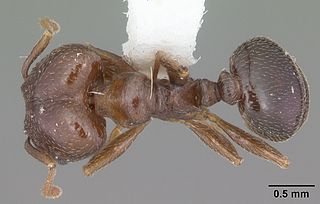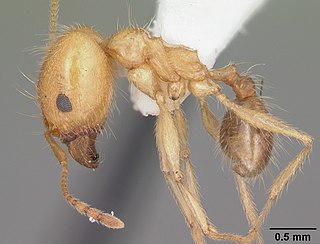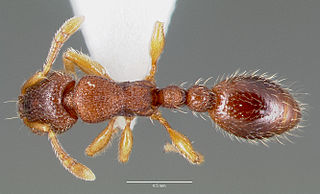
Pheidole is a genus of ants that belongs to the ant subfamily Myrmicinae. The genus is widespread and ecologically dominant. It probably includes more than a thousand species. The genus first evolved in the Americas, eventually spreading across the globe.
Barry Bolton is an English myrmecologist, an expert on the classification, systematics, and taxonomy of ants, who long worked at the Natural History Museum (London). He is known especially for monographs on African and Asian ants and for three encyclopaedic global works, including the Identification Guide to Ant Genera (1994), a full catalogue of ant taxa, and a synopsis and classification (2003). Now retired, Bolton is a Fellow of the Royal Entomological Society and Myrmecologist, Biodiversity Division, Department of Entomology, Natural History Museum, London.

Pheidole megacephala is a species of ant in the family Formicidae. It is commonly known as the big-headed ant in the USA and the coastal brown ant in Australia. It is a very successful invasive species and is considered a danger to native ants in Australia and other places. It has been nominated as one of the hundred "World's worst" invaders.

Pheidole metallescens is an ant, a species of higher myrmicine in the family Formicidae.

Pheidole vistana is a species of ant and a higher myrmicine in the family Formicidae.

Pheidole moerens is an ant, a species of higher myrmicine in the family Formicidae.

Pheidole rhea is a species of ant and a higher myrmicine in the family Formicidae.

Pheidole tysoni is a species of ant and a higher myrmicine in the family Formicidae.

Pheidole xerophila is a species of ant and a higher myrmicine in the family Formicidae.

Pheidole californica is an ant, a species of higher myrmicine in the family Formicidae.

Pheidole obtusospinosa is a species of ant and a higher myrmicine in the family Formicidae.

Pheidole pilifera is a species of ant and a higher myrmicine in the family Formicidae.

Pheidole hyatti is an ant, a species of higher myrmicine in the family Formicidae.

Pheidole crassicornis is an ant, a species of higher myrmicine in the family Formicidae.

Pheidole morrisii is a species of ant and a higher myrmicine in the family Formicidae.

Vollenhovia emeryi is a species of ant in the family Formicidae.

Pheidole cerebrosior is a species of higher myrmicine in the family Formicidae.

Formica neogagates is a species of ant in the family Formicidae. Found throughout North America and Canada, introduced in Europe, France.

Monomorium ergatogyna is a species of ant in the family Formicidae. This species is often mistaken for Monomorium minimum as they are similar in appearance. This ant is a shiny black color and contains only a single worker caste, making them a monomorphic species. It is also polygyne, meaning a colony contains multiple fertile queens living together. They are native to California, Nevada, and Utah and are usually found in cities or on the coast. When compared to other Monomorium species, they are found to have the longest living queens and can live up 2 years in captivity. Argentine ants have been discovered to be actively pushing this species out of its original territory.


















